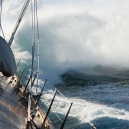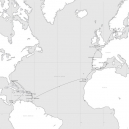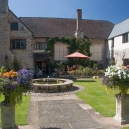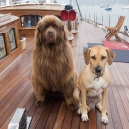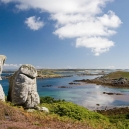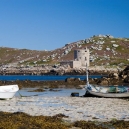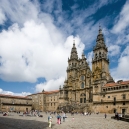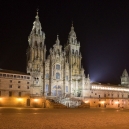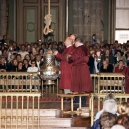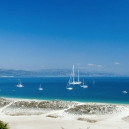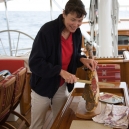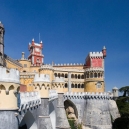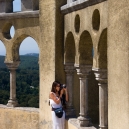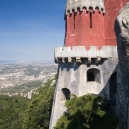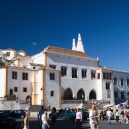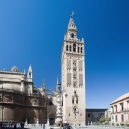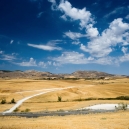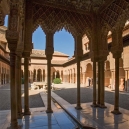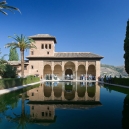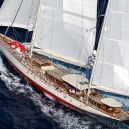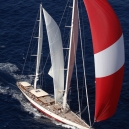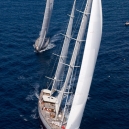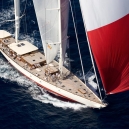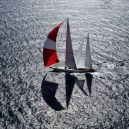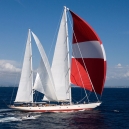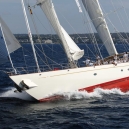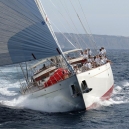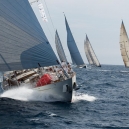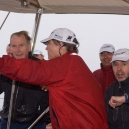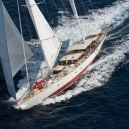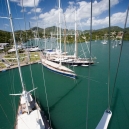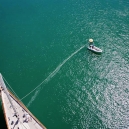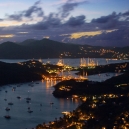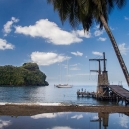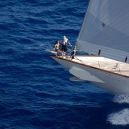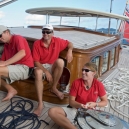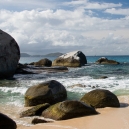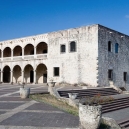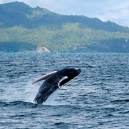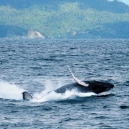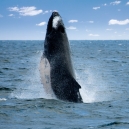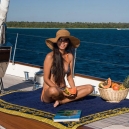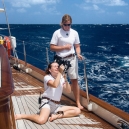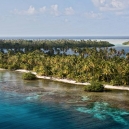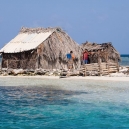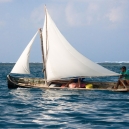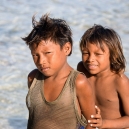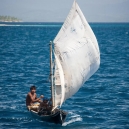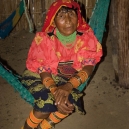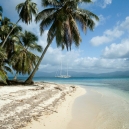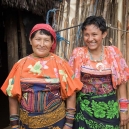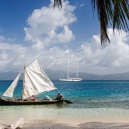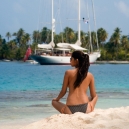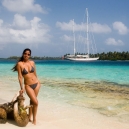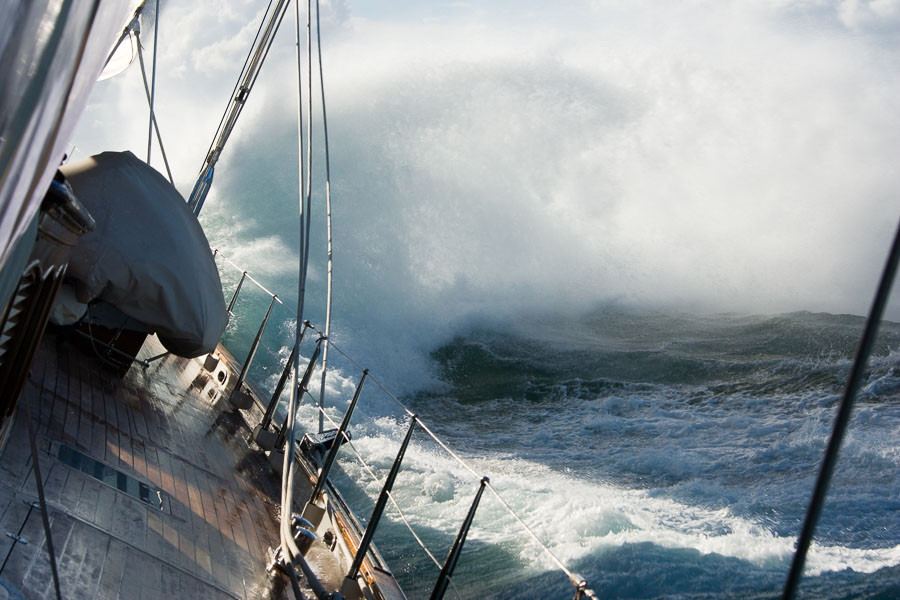 The original plan was to go westwards from Sweden to the Faeroes, Iceland, Greenland and finally Canada. But persistent headwinds of 50 knots or more forced us to change plans and go south and cross the Atlantic the traditional way.
The original plan was to go westwards from Sweden to the Faeroes, Iceland, Greenland and finally Canada. But persistent headwinds of 50 knots or more forced us to change plans and go south and cross the Atlantic the traditional way. So we made a new route to England and Spain and then across to the Caribbean.
So we made a new route to England and Spain and then across to the Caribbean. Meanwhile we had a chance to stop at Knightstone Manor.
Meanwhile we had a chance to stop at Knightstone Manor. Our dogs, Chucky and nallah, came aboard in Dartmouth
Our dogs, Chucky and nallah, came aboard in Dartmouth Our final stop in Britain was the Scilly Isles. This is a view from Bryher.
Our final stop in Britain was the Scilly Isles. This is a view from Bryher. The Scilly Isles. The sound between Tresco and Bryher at low tide.
The Scilly Isles. The sound between Tresco and Bryher at low tide. The Cathedral of Santiago de Compostela, the destination of the old Pilgrims' Way. The baroque shell hides a dark medieval interior, where the pilgrims slept in the upper galleries
The Cathedral of Santiago de Compostela, the destination of the old Pilgrims' Way. The baroque shell hides a dark medieval interior, where the pilgrims slept in the upper galleries The cathedral at night
The cathedral at night
 Islas Cies in northwest Spain are blessed by this white sand.
Islas Cies in northwest Spain are blessed by this white sand. Claire, our chef, carving the local ham that we also had in all the tapas bars in Spain.
Claire, our chef, carving the local ham that we also had in all the tapas bars in Spain. Palacio de Pena in Sintra, north of Cascais in Portugal. Sintra's history dates back to Moorish times, but this is a rnineteenth century palace built on the ruins of an old monastery.
Palacio de Pena in Sintra, north of Cascais in Portugal. Sintra's history dates back to Moorish times, but this is a rnineteenth century palace built on the ruins of an old monastery. I am not the only photographer.
I am not the only photographer. This is the tower that Jennifer was photographing. It is part of Palacio de Pena.
This is the tower that Jennifer was photographing. It is part of Palacio de Pena. The medieval architecture of the Palacio National de Sintra is uniquely preserved. Most of what can be seen today was built by Dom Joao in the late fourteenth century. The two chimneys in the background are from the original kitchen.
The medieval architecture of the Palacio National de Sintra is uniquely preserved. Most of what can be seen today was built by Dom Joao in the late fourteenth century. The two chimneys in the background are from the original kitchen. The cathedral in Sevilla in southern Spain. The clock tower, La Giralda, is from the minaret of an earlier mosque. It was completed in 1198.
The cathedral in Sevilla in southern Spain. The clock tower, La Giralda, is from the minaret of an earlier mosque. It was completed in 1198. The relentless heat of the Andalucian summers creates its own stark beauty.
The relentless heat of the Andalucian summers creates its own stark beauty. Patio de los Leones - Courtyard of the Lions - is the heart of the harem at the Alhamra palace. The fountain with the lions can be seen in the background.
Patio de los Leones - Courtyard of the Lions - is the heart of the harem at the Alhamra palace. The fountain with the lions can be seen in the background. Water is used in Moorish architecture to cool the courtyards but also to play with light and reflection, emphasizing the importance of symmetry and repetition in Moorish art.
Water is used in Moorish architecture to cool the courtyards but also to play with light and reflection, emphasizing the importance of symmetry and repetition in Moorish art. Adele during the first day of the Superyacht Cup in Palma, Sep 2005
Adele during the first day of the Superyacht Cup in Palma, Sep 2005 Adele on a downwind leg of the race
Adele on a downwind leg of the race All the pictures of the race were taken by Rick Tomlinsson. I was at the wheel all the time and exhasuted in the evenings.
All the pictures of the race were taken by Rick Tomlinsson. I was at the wheel all the time and exhasuted in the evenings. We had a crew of 40 but during the third day of racing that number had increased to 50.
We had a crew of 40 but during the third day of racing that number had increased to 50. Bright sun and sharp shadows make for a vivid image - with the help of a helicopter
Bright sun and sharp shadows make for a vivid image - with the help of a helicopter Notice the guy hanging from the top of the mast.
Notice the guy hanging from the top of the mast. The finishing leg
The finishing leg The helicopter must have been quite low for Rick to take this shot. A sharp viewer can see me at the helm.
The helicopter must have been quite low for Rick to take this shot. A sharp viewer can see me at the helm. Towards the end of the race. Adele won the first day's racing
Towards the end of the race. Adele won the first day's racing An exciting moment on the second day's racing. This day Rick was aboard and the weather was less benign.
An exciting moment on the second day's racing. This day Rick was aboard and the weather was less benign. Crossing the finishing line.
Crossing the finishing line. After Palma we left the Med for the Canary Islands and then the crossing to the Caribbean. The first port of call was English Harbour in Antigua.
After Palma we left the Med for the Canary Islands and then the crossing to the Caribbean. The first port of call was English Harbour in Antigua. Here a helping dinghy from the harbourmaster's office is helping us attach the mooring lines to a buoy.
Here a helping dinghy from the harbourmaster's office is helping us attach the mooring lines to a buoy. English Harbour with Falmouth Harbour in the background. The picture was taken at Shirley Heights, where a steel band plays for tthe visitors every Sunday at sunset
English Harbour with Falmouth Harbour in the background. The picture was taken at Shirley Heights, where a steel band plays for tthe visitors every Sunday at sunset The setting for the movie "Pirates of the Caribbean" on the island of St Vincent
The setting for the movie "Pirates of the Caribbean" on the island of St Vincent Jennifer and me at the bow during sailing
Jennifer and me at the bow during sailing Some of the crew enjoying the sailing as well as each other's company.
Some of the crew enjoying the sailing as well as each other's company. The Baths in Virgin Gorda, British Virgin Islands, are the home for rounded stone boulders, hidden walkways, mystical pools and grottos.
The Baths in Virgin Gorda, British Virgin Islands, are the home for rounded stone boulders, hidden walkways, mystical pools and grottos. The palace of Diego Columbus, the son of New World discoverer Christopher Columbus, in Santo Domingo.
The palace of Diego Columbus, the son of New World discoverer Christopher Columbus, in Santo Domingo. A baby humpback whale breaching in Samana Bay in the northern part of Hispaniola.
A baby humpback whale breaching in Samana Bay in the northern part of Hispaniola. This baby could be around six metres long
This baby could be around six metres long Mature humpback. Each year 10,000 whales congregate in Samana Bay to breed, but they don't feed. Then they swim north to arctic waters to feed during the summer months returning to Hispaniola next winter again.
Mature humpback. Each year 10,000 whales congregate in Samana Bay to breed, but they don't feed. Then they swim north to arctic waters to feed during the summer months returning to Hispaniola next winter again. Jennifer on the foredeck, while Adele is at anchor in the Dominican Republic.
Jennifer on the foredeck, while Adele is at anchor in the Dominican Republic. From Hispaniola we sailed to Panama. Gillian is tought by Georgina how to use a sextant on the downwind crossing.
From Hispaniola we sailed to Panama. Gillian is tought by Georgina how to use a sextant on the downwind crossing. Verdant beaches and crystal clear water met us in the San Blas Islands
Verdant beaches and crystal clear water met us in the San Blas Islands This is what I call a house with a sea view! The Kuna Indians live on tiny cays, where nothing can grow, so their gardens, where they grow vegetables and have coconut trees are on the mainland.
This is what I call a house with a sea view! The Kuna Indians live on tiny cays, where nothing can grow, so their gardens, where they grow vegetables and have coconut trees are on the mainland. These sailing canoes are still used as the means for transportation from the homes on the islands to their gardens on the mainland.
These sailing canoes are still used as the means for transportation from the homes on the islands to their gardens on the mainland. This brother and sister lived on one of the numerous cays. The accompanied me aroung their little island and suggested plenty of phtographic ideas.
This brother and sister lived on one of the numerous cays. The accompanied me aroung their little island and suggested plenty of phtographic ideas. Another sailing canoe.
Another sailing canoe. Mrs Alemancia, the mother of our guide around the Kuna villages. She is, like all Kuna women, dressed in traditional costume.
Mrs Alemancia, the mother of our guide around the Kuna villages. She is, like all Kuna women, dressed in traditional costume. Gunboat Island, San Blas.
Gunboat Island, San Blas. Grandmother and daughter outside their hut in Rio Sidra, San Blas. The traditionally embroided blouse, the Mola, is typical for the island culture.
Grandmother and daughter outside their hut in Rio Sidra, San Blas. The traditionally embroided blouse, the Mola, is typical for the island culture. Two beautiful yachts.
Two beautiful yachts. And again two contrasting beauties. This image was on the cover of Yachting World.
And again two contrasting beauties. This image was on the cover of Yachting World. We were the only ones on this islands during our visit, but in the background another yacht can be seen anchored close to another cay.
We were the only ones on this islands during our visit, but in the background another yacht can be seen anchored close to another cay.
South via England, Spain and Portugal to the Med and then across to the Caribbean and down to Panama.

